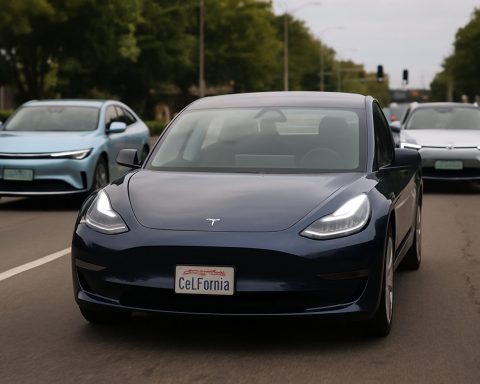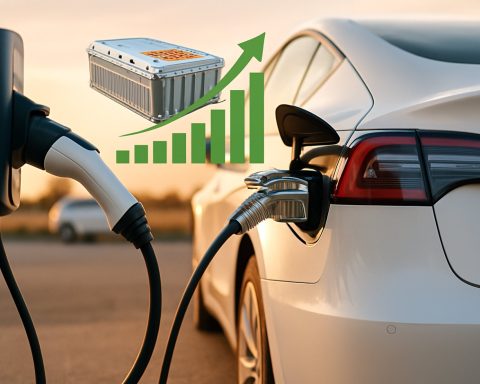- South Korean scientists at UNIST are pioneering advancements in electric vehicle (EV) battery technology, aiming to enhance efficiency and safety.
- A pivotal development is a unique cathode capable of storing up to 70% more energy, potentially extending EV range to over 600 miles per charge.
- A key challenge is mitigating the risk of volatile oxygen gas release at 4.25 volts, which could lead to explosions.
- By replacing certain transition metals in the cathode with elements of lower electronegativity, researchers have stabilized electron movement to prevent hazardous oxidation.
- Advanced X-ray analysis plays a crucial role in monitoring oxygen behavior; however, similar issues arise in international research efforts.
- The advancements promise faster charging times, longer ranges, and improved safety, advancing the EV market and promoting a greener future.
Across the bustling city of Ulsan, amid the hum of innovation, South Korean scientists have embarked on a quest that promises to redefine the electric vehicle (EV) landscape. Nestled within the hallowed halls of the Ulsan National Institute of Science and Technology (UNIST), researchers have unearthed a lingering dilemma in battery technology—a puzzle that holds the key to propelling EVs into a new era of efficiency and safety.
Picture this: a battery that could extend the range of your electric car to more than 600 miles on a single charge. The secret lies within a unique cathode capable of up to 70% more energy storage through elevated voltage charging. However, as with many stories of technological ascent, a formidable challenge lurks in the shadows.
The excitement of a potent cathode is tempered by the risk of volatile oxygen gas releasing at 4.25 volts. With potential explosions at stake, researchers are acutely aware that safety cannot be compromised. In their relentless pursuit to conquer this challenge, UNIST’s experts developed a strategy that reimagines the structure of these quasi-lithium cathodes. By cleverly substituting some transition metals with those of lower electronegativity, they have taken a bold step to tame the reactive beast within.
This innovative maneuver stabilizes electron movement, hence preventing the hazardous oxidation that has stymied previous advancements. The heart of this method lies not in fixing emitted gases but in thwarting oxygen’s oxidation at the source—a revelation that sets this UNIST research apart.
Advanced X-ray analysis underpins these efforts, enabling precise scrutiny of oxygen’s behavior. Intriguingly, while South Korea makes strides, researchers at Russia’s Skolkovo Institute of Science and Technology grapple with their own challenges. Their findings suggest that X-ray examinations might inadvertently trigger similar oxygen issues in certain cathodes, underscoring the nuanced complexity of this global endeavor.
But why does this matter? The expanding frontier of battery science promises ultra-fast charge times, unparalleled range benchmarks, and a future where electric vehicles not only rival but surpass their gasoline counterparts. Safety, often spotlighted in fiery lithium-ion missteps, remains a smaller risk than traditional gasoline cars, yet an undeniable concern.
As the EV market rides a wave of popularity—evidenced by a 25% surge in sales last year—these innovations symbolize more than mere technological prowess. They hold the promise of a cleaner, safer, and greener future for transport. In cracking this enigma, South Korean research has not just inched closer to unlocking phenomenal EV potential; it has heralded a dawn where lengthy roads and eco-conscious dreams converge seamlessly.
The Future of EVs: How South Korean Innovations Are Charging Toward a Breakthrough
Introduction
The electric vehicle (EV) industry is on the cusp of a revolution, thanks to groundbreaking advancements in battery technology being spearheaded at Ulsan National Institute of Science and Technology (UNIST) in South Korea. Researchers there have addressed a critical challenge: enhancing the energy capacity of EV batteries while maintaining safety. This development could enable EVs to travel more than 600 miles on a single charge, transforming the automotive landscape.
Key Innovations and Insights
1. Improved Energy Storage: The unique cathode design developed at UNIST offers up to 70% more energy storage. This significant leap is achieved through charging at elevated voltages.
2. Safety Concerns and Solutions: Traditionally, operating at high voltages could cause the release of volatile oxygen gas—posing explosion risks. The innovation in cathode design involves the substitution of certain transition metals to stabilize electron movement and prevent hazardous oxidation at 4.25 volts. This breakthrough makes these high-capacity batteries much safer to use.
3. Advanced Analysis Tools: Utilizing advanced X-ray analysis, researchers can monitor oxygen behavior and enhance battery design stability. This precision tool is instrumental in understanding and refining the technology further.
Real-World Use Cases
– Extended Range Vehicles: This technology paves the way for EVs capable of long-distance travel, making them suitable for everything from city commutes to cross-country road trips without the need for frequent charging stops.
– Commercial Fleets: Businesses operating delivery services could benefit from longer range vehicles, reducing downtime for charging and minimizing operational costs.
Market Forecasts and Industry Trends
– Increasing EV Popularity: With a 25% surge in EV sales last year, the market is rapidly expanding. This new battery technology could further accelerate growth as range anxiety diminishes.
– Global Research Developments: As a leader in battery innovation, South Korea is poised to influence global EV trends. Companies may look to form partnerships or adapt these innovations.
Comparisons and Limitations
– EV vs. Traditional Vehicles: While EVs are already considered safer and more eco-friendly compared to gasoline cars, these battery advancements may further widen the gap by offering greater range and safety.
– Challenges of Global Adoption: While South Korean researchers are making strides, the technology needs to be tested and refined for widespread global deployment to ensure it meets diverse market needs.
Insights and Predictions
– Future Integration: Expect battery improvements to become a standard in high-end and eventually mainstream EV models, facilitating a shift to electric that could challenge gasoline dominance.
– Environmental Impact: Long-term, these innovations can lead to significant reductions in carbon emissions, aiding the global push toward sustainable transport.
Actionable Recommendations
– Stay Informed: Investors and consumers should monitor developments in battery technology, as they will influence market opportunities and vehicle availability.
– Adopt Early: For those considering purchasing an EV, staying updated with the latest models featuring these new batteries can offer both improved performance and peace of mind concerning range.
Conclusion
The advancements in battery technology led by South Korea’s UNIST are set to redefine the EV market, offering enhanced range and safety. As these breakthroughs dovetail with global trends toward sustainability and electrification, the future of transportation looks greener and more promising than ever.
For more about technological innovations and their impacts, visit UNIST.












